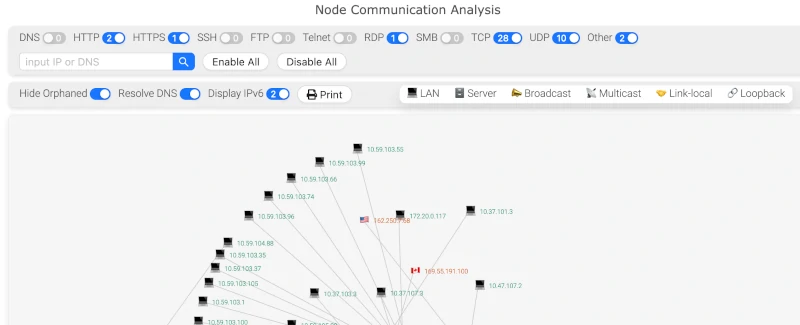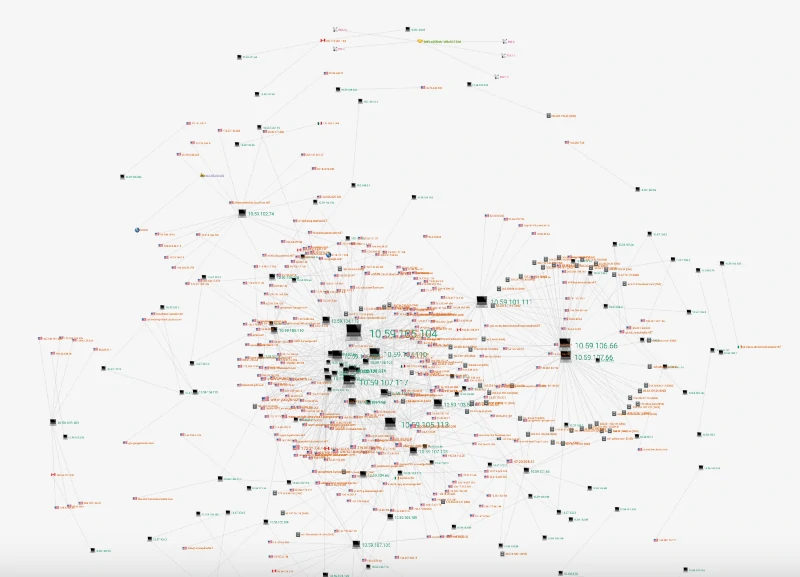Exploring the Network Section: Interactive Network Mapping with A-Packets
In the field of network administration and cybersecurity, the ability to visualize network activity quick is crucial for achieving a deep understanding of how data flows throughout your network. Whether you're managing a local network or overseeing a complex web of global connections, having access to a clear, interactive map of your network traffic is invaluable. Such a map not only enhances your ability to monitor the network but also plays a vital role in securing your infrastructure against potential threats.
This is where the Network section of our service becomes indispensable, offering a robust and intuitive platform to visualize network connections and activities with precision and ease. By transforming complex data into actionable visual insights, the sextion empowers you to make informed decisions, optimize performance, and fortify your network's defenses.

Interactive map of the network section
The Power of Interactive Network Mapping
The Network section is crafted to equip network administrators and security engineers with a powerful interactive map that simplifies the complexities of modern network environments. In today's interconnected world, networks are more intricate than ever, with numerous nodes, diverse network traffic types, and potential security threats lurking within the data. The ability to visualize these elements cohesively is essential for maintaining robust network health and security.
By converting raw network data from PCAP files into an intuitive visual format, the Network section enables users to quickly and effectively interpret complex information. This visualization process transforms what would otherwise be overwhelming datasets into a clear, interactive map where key network nodes, connections, and traffic patterns are readily accessible. This not only aids in routine monitoring but also in swiftly identifying any anomalies or unusual activities that could signify potential security risks.
Moreover, the Network section's ability to bring clarity to vast amounts of network data is invaluable for proactive security management. Network administrators and security engineers can easily pinpoint areas of concern, such as unexpected traffic flows or unrecognized devices, allowing for immediate investigation and response. This proactive approach to network visualization ensures that potential threats are detected early, reducing the risk of breaches and enhancing overall network resilience.
Comprehensive Node Information
One of the standout aspects of the section is its ability to display detailed information about each node on your network. This includes IP addresses, domain names, and geolocation data, all of which are essential for understanding where your traffic is coming from and going to. By providing a visual representation of this data, you can easily see the relationships between different nodes, helping you to identify any unusual or suspicious connections.
Interactive Filtering of Protocols
In any network, traffic can consist of various protocols, making it challenging to analyze specific types of data. The Network section allows you to filter this traffic interactively, focusing on the protocols that matter most to your analysis. Whether you're interested in HTTP, HTTPS, DNS, or any other major protocol, you can easily isolate and examine this traffic within the map, making your analysis more efficient and targeted.

Filtering of Protocols
Geolocation Insights
Understanding the geographic distribution of your network nodes can provide critical insights into traffic patterns and potential security concerns. The Network section includes geolocation data for each node, allowing you to see not only where your traffic is coming from but also how it moves across different regions. This is particularly useful for identifying region-specific threats or ensuring that your network complies with local regulations.
Services Info
In addition to basic IP and DNS information, our service extracts and displays additional data about each node, such as open ports, running services, and installed applications detected by network activities. This data is crucial for identifying potential vulnerabilities within your network, as it gives you a deeper understanding of the configuration and security posture of each node. By visualizing this information, the Network section helps you pinpoint areas that might require further investigation or strengthening.

Service Info
Support for IPv4 and IPv6 Traffic
As networks evolve, the transition from IPv4 to IPv6 becomes increasingly important. The Network section supports both types of traffic, ensuring that you have a complete picture of your network, regardless of the IP versions in use. This capability is essential for modern network management, where dual-stack environments are becoming more common.
Automatic Group Identification
One of the most powerful aspects of the Network section is its ability to automatically identify and classify groups of nodes based on their connections. This feature helps you quickly identify clusters of nodes that frequently communicate with each other, which could be indicative of normal business operations or potentially coordinated malicious activity. The automatic classification reduces the time and effort required for manual analysis, allowing you to focus on the most critical aspects of your network.

Groups identification
Conclusion
The Network section in our service is a game-changer for network administrators and security specialists alike. By offering a map of your network, complete with detailed node information, protocol filtering, geolocation data, and more, it provides a comprehensive view of your network's activity. Whether you're looking to optimize performance, enhance security, or simply gain a better understanding of your network, the Network section is an invaluable tool.
As part of a series introducing you to the powerful features of our service, this article highlights how the Network section can transform the way you visualize and manage your network. Stay tuned for more insights into how our service can help you stay ahead in the ever-changing world of network management and cybersecurity.